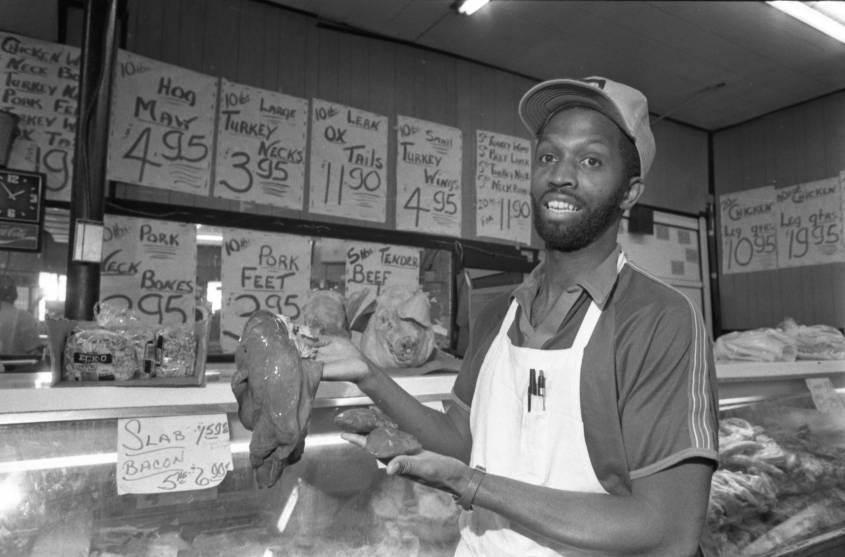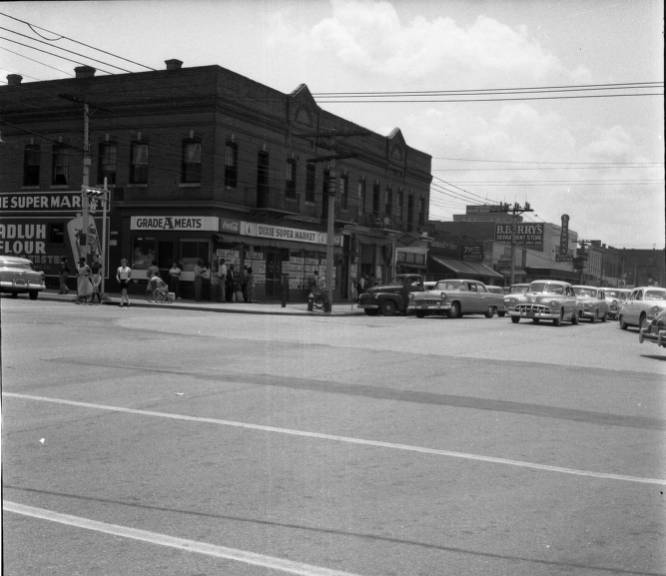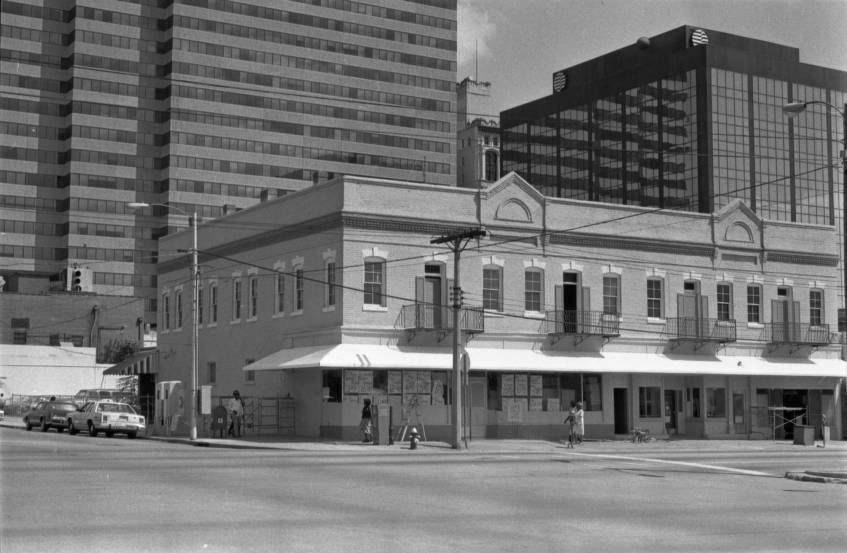- Margaret D.
- Tuesday, March 28, 2023
From 1937 to 1988 there was a unique supermarket at 1438 Assembly Street.
Located on the corner of Hampton and Assembly Streets in downtown Columbia, Dixie Super Market was known for selling every part of the pig or cow. Its shoppers knew how to turn heads, feet, livers, mountain oysters, chitlins, or tails into a fine meal. And in the summer, local produce such as plums, peaches, and scuppernongs were available.
“We sell anything that the hog’s got on him,” said store manager David Baker in a 1985 interview with a reporter with the Columbia Record newspaper.
This market served the neighboring communities of Arsenal Hill, Seaboard Park, and Ward One, all once home to working class, mostly Black, families who lived within walking distance to the supermarket. Later, when more people had cars, people from Greenview and other suburban communities would drive downtown just to shop at Dixie Super Market.

The building at 1438 Assembly Street was built in 1901 and held several businesses and grocery stores until Norman Khoury, a Lebanese immigrant, first opened Dixie Super Market in 1937. The interior of the store featured a bucolic mural painted by noted artist James Gordon Heise. In 1940, Khoury's son Hasham took over managing Dixie Super Market. Except for his time in the Army during World War II, Hasham Khoury operated the business continually until 1988. In those 50-plus years, Hasham established a friendly relationship with his customers who appreciated the wide variety of meat products he sold at very reasonable prices. Dixie's customers were hard-working people but were often in low-wage jobs and didn’t have a lot to spare for weekly groceries. Khoury found that by offering neighborly service, selling a wide variety of cuts of meat, and employing members of the local community, he gained a very loyal following.

Dixie Super Market would see a great many changes to the area during its half decade in business. When Khoury first established the business there were large swaths of houses west of Assembly Street down to the river. There were industrial businesses in Seaboard Park (now Finlay Park) such as Seaboard Railway and the City Ice Company, and commercial districts along Main and Washington Street brought many other people into the area to shop or dine. The Phyllis Wheatley YWCA and Howard School operated just blocks away. And there was a baseball field and community center for African Americans down the hill on Hampton Street. Khoury did not discriminate against African Americans as other white store owners in the area did at the time. He was happy to do business with anyone and to offer whatever products his customers desired. This attitude served him well.
In 1966, the modern United States Post Office opened on Assembly Street one block north of Dixie Super Market, bringing dollars and attention to the area. But some of this attention would result in the removal of the homes in the surrounding neighborhoods. As time marched on, the neighborhoods west of Assembly Street were completely lost to urban renewal. The end of Jim Crow segregation, of course a positive development for social justice, also meant the end of the Black business district along Washington Street. The expansion of suburban neighborhoods around Columbia, and the improvement of roads and car travel, all resulted in a shrinking customer base for downtown businesses through the 1970s and 1980s.

In the mid-1980s Khoury remodeled his building’s façade in an effort to keep up with the new, upscale look expected for downtown businesses. But, eventually, Khoury grew older, the downtown customer-base dwindled, and Dixie Super Market saw its final days. The building was demolished in 1988, but just before the wrecking ball came through a reporter took a photograph of the Heise mural. The area is now a parking lot, and I can look out on the former site of it from the windows at the Main Library.

Sometimes, walking past that corner, I think of the meat counter of hog’s heads and the once-lively community that is now just a memory. Change in any city is inevitable. Yet it is interesting to rediscover these people, places, and stories that added color (and flavor!) to our city’s history.
Sources:
- “Different: Dixie outwardly fits uptown image but keeps inside flavor.” Warren Bolton, Columbia Record, October 3, 1985, Neighbors Zone 3, p.1.
- “Parts is parts: Familiar downtown grocery store to be closing doors later this year.” Warren Bolton, Columbia Record, January 9, 1987 p. C-1.
- “Real peace: Khoury’s never strayed far away from the church.” Kay Gordon, Columbia Record, September 8, 1987, p. C-1.
- “Mural doomed: Artwork at Dixie Supermarket to be town down with building.” Charles A. Twardy, The State, February 17, 1988 p. B-1
- Obituary for Hasham Paul Khoury. The State, May 17, 2012 p. B-2.


